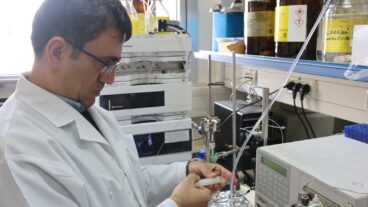A joint Israeli-American study has identified a drug that could prevent changes in the brain that lead to epilepsy after brain trauma.
For people who suffer severe head injuries, there’s good news and bad news. The good news is that because of better medical care, many people who would have previously died of their injuries now survive. The bad is that between 25-50 percent of them will go on to develop epilepsy, and currently no treatment exists to prevent this happening.
Now an Israeli neurosurgeon believes he may have an answer. Dr. Alon Friedman, a professor and researcher at Ben-Gurion University of the Negev, together with researchers from UC Berkeley, California has identified a TGF Beta Blocker that prevents epilepsy after traumatic brain injury in rats.
If the findings, which were published this month in The Journal of Neuroscience, are confirmed in humans, a TGF-beta blocker may prevent many cases of epilepsy in accident victims, Iraqi war GIs who suffer from brain trauma after roadside bomb attacks, or people who develop epilepsy after brain tumors, meningitis or other infections to the brain.
In the Western world, epilepsy affects approximately five million people, with some 400,000 new cases diagnosed each year. According to the National Institute of Neurological Disorders and Stroke in the US, approximately 2.3 million Americans currently live with epilepsy, and each year, an estimated 25,000 to 50,000 die of seizures and related causes.
A storm of electricity
“Once epilepsy develops, drugs are the only option, and even those fail to control seizures in 30% of cases,” says Friedman, a leading researcher at BGU’s Brain Imaging Research Center, who works closely with BGU’s Dr. Moni Benifla, an epilepsy surgeon, and Dr. Ilan Shelef, a neuroradiologist.
Epilepsy happens when neurons fire together in synchrony, leading to a storm of electricity, says Daniela Kaufer, an assistant professor of integrative biology at the University of California, Berkeley. “The brain by itself has mechanisms to inhibit that release of inhibitory signals through an inhibitory neurotransmitter that is supposed to shut down the firing. In epilepsy, you don’t get shutdown of firing and it spirals out of control,” she explains.
In the wake of brain trauma, the uninhibited firing of neurons – so called hyper-excitability – can exhaust and kill the neurons, altering the nerve network in the brain and leading to reorganization of neurons to create short-circuits that precipitate seizures.
In experiments on rats, the researchers found that they could prevent the brain changes leading to epilepsy by treating the animals with a drug that blocks transforming growth factor-beta receptor (TGF-beta).
Using the drug, they could block the hyper-excitability normally present after a brain trauma. The drug also prevents a majority of the gene expression changes that they identified following brain injury.
A leak in the blood-brain barrier
“Because seizures develop weeks to years after an injury, there is a large window of opportunity in which patients could be treated with drugs to prevent the development of seizures,” says Kaufer.
Kaufer has been studying the cause of brain injury induced epilepsy for 14 years.
He first became interested in the subject when he was a physician in the Israel Defense Forces (IDF), hypothesizing that epilepsy after a brain trauma is caused by a leak of blood components into the brain through the damaged blood-brain barrier – a sheath of tightly joined cells that lines the capillaries in the brain to prevent intrusion of bacteria and potentially dangerous blood-borne molecules.
Since then he and his colleagues at BGU have developed imaging tools that can measure the blood-brain barrier opening.
In 2004, Friedman published the first direct evidence in animal experiments, showing that opening the blood-brain barrier and the diffusion of blood components into the brain results in the development of epilepsy.
Albumin could be the culprit
Friedman teamed up with Daniela Kaufer, then a graduate student at Hebrew University, on a series of experiments that has gradually provided support for the hypothesis and convinced many that this is a totally new and valuable way of looking at epilepsy.
Now in Berkeley, Kaufer has teamed with Friedman and other colleagues to systematically sift through the components of the blood and, in 2007, reported that the major culprit in epileptogenesis seemed to be albumin, the main protein in blood serum.
This research won Friedman the prestigious international prize for Epilepsy research in 2007 (The Michael Prize) and both Kaufer and Friedman received a highly prestigious grant award from CURE (Citizens United for Research in Epilepsy) in 2008.
Using this research, Kaufer believes that it will be possible to identify brain injury patients that are more susceptible to epilepsy development and then treat only those patients with the new drug. “At least in the rats, that works now,” she says.












